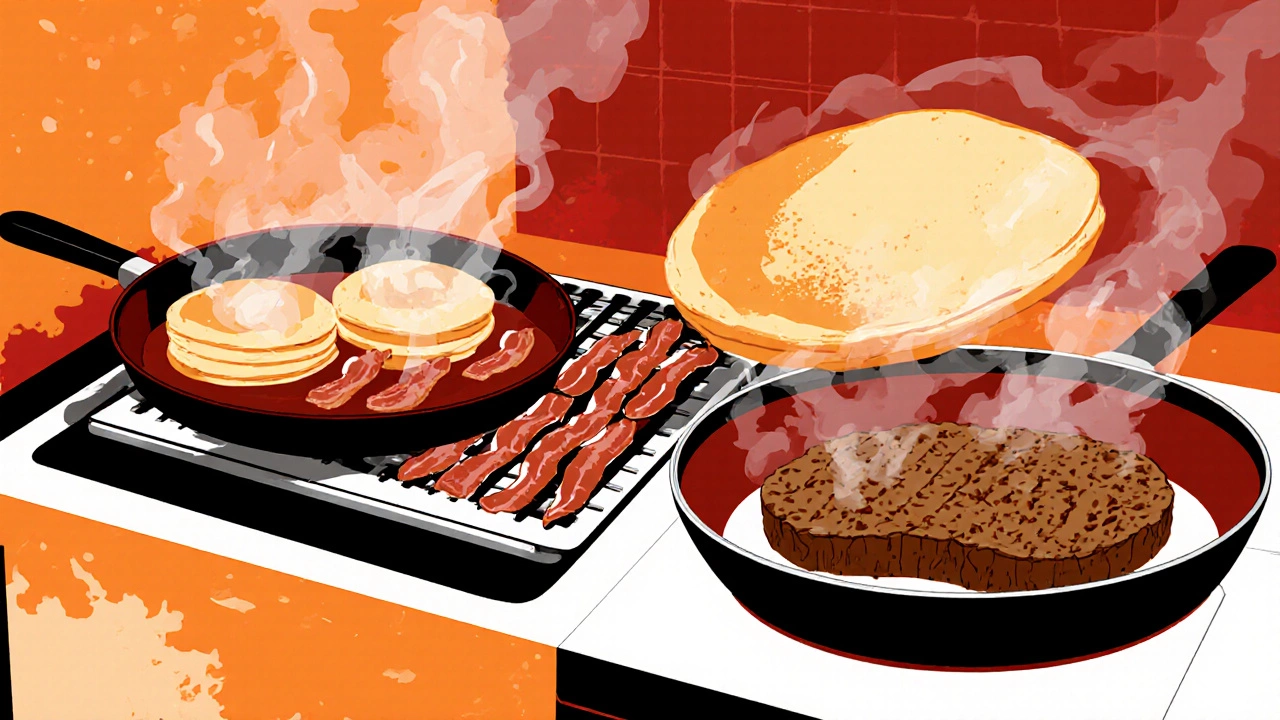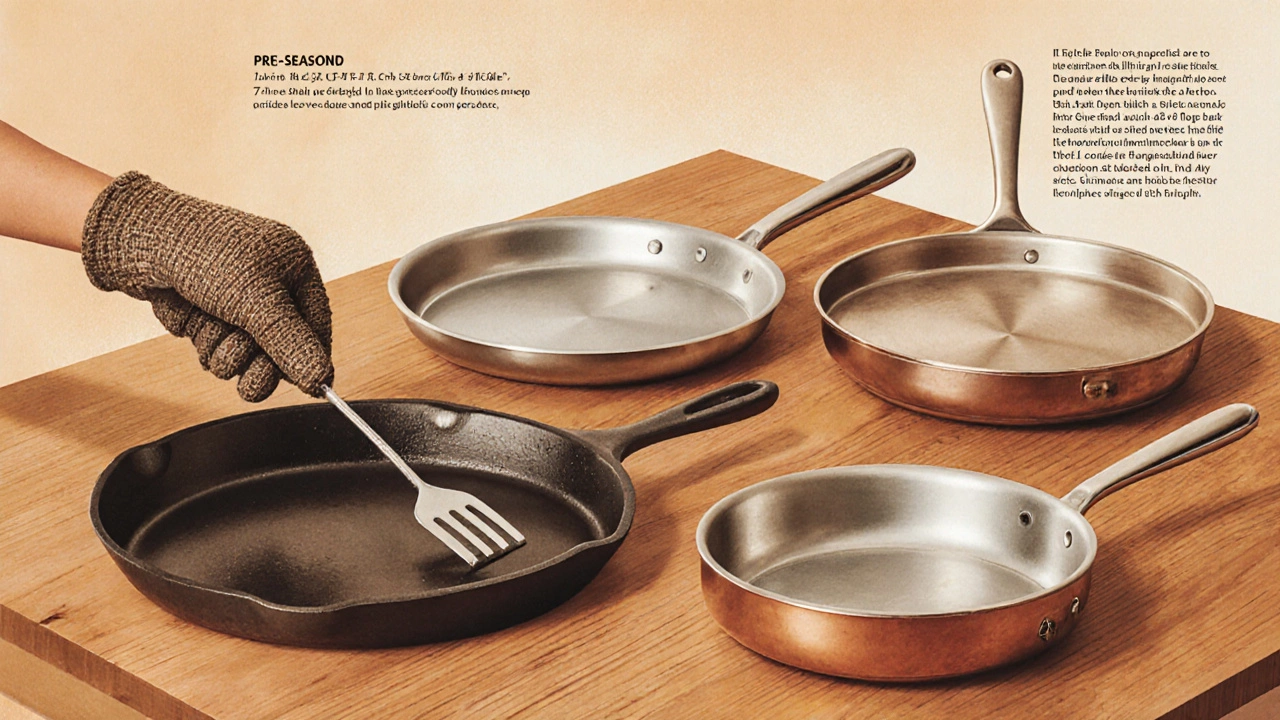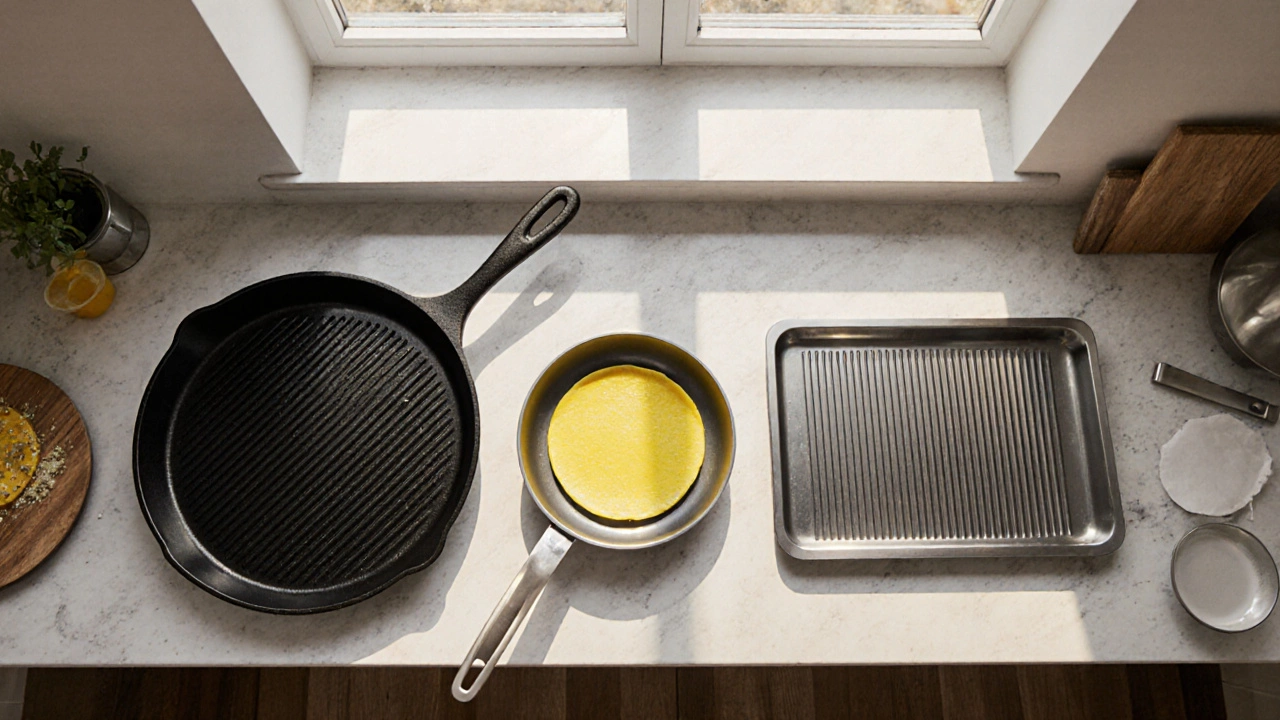Flat Pan Selector
What do you want to cook?
What heat source do you have?
What material preference do you have?
Ever wondered what a flat pan is called? You’re not alone - the kitchen is full of similar‑looking tools, each with its own name and purpose. In this guide we’ll break down the most common flat‑bottomed pans, explain how they differ, and help you pick the right one for your next meal.
Quick Takeaways
- A flat pan is any shallow, low‑sided cooking vessel with a level bottom.
- Common names include griddle, crepe pan, tavă, plancha and even some skillets.
- Material (cast iron, stainless steel, non‑stick) determines heat retention and cleaning needs.
- Choose size based on the dishes you cook most - pancakes need a wide surface, while a small crepe pan works for delicate folds.
- Proper care (seasoning, gentle cleaning) extends the life of any flat pan.
What Exactly Is a Flat Pan?
Flat pan is a cooking vessel with a flat bottom and low, often flared, sides that allow heat to circulate quickly across the surface. Unlike deep pots or casseroles, a flat pan’s primary job is to sear, brown, or cook food that benefits from direct contact with a hot surface.
Because the design is so simple, many cultures have given the basic shape their own name and a few tweaks - a little extra lip here, a different handle there - creating a family of pans that all fall under the flat pan umbrella.
Names You’ll Hear Around the Kitchen
Below are the most popular flat‑pan variants, each with a brief definition and typical use.
Griddle is a large, flat cooking surface, traditionally made of cast iron or steel, used for foods that need a broad, even heat zone - think pancakes, bacon, and grilled sandwiches.
Crepe pan is a small, low‑sided skillet, often with a non‑stick coating, designed for ultra‑thin French crepes.
Tavă (pronounced "tah‑vah") is a South Asian iron or steel plate that sits directly on the stovetop, perfect for making dosas, roti or stir‑fry.
Plancha is a Spanish‑style metal sheet, sometimes ribbed, used for high‑heat searing of seafood, vegetables, and thin cuts of meat.
Skillet (or frying pan) can be considered a flat pan when the sides are shallow and the bottom is especially flat, suitable for sautéing and pan‑frying.

How to Choose the Right Flat Pan for You
Not every flat pan works for every job. Keep these factors in mind before you click ‘add to basket’.
- Material
- Cast iron offers excellent heat retention, ideal for slow‑cook sears and dishes that benefit from a steady temperature.
- Stainless steel heats quickly and reacts less with acidic foods, but often needs an aluminum or copper core for even distribution.
- Non‑stick coating provides easy release for delicate items like crepes, though it can’t handle ultra‑high heat.
- Size and Shape
For family‑style breakfasts, a 12‑inch griddle works best. For single‑serving crepes, a 7‑inch crepe pan is perfect. Consider storage space - larger pans need more cabinet room.
- Handle Design
Long handles stay cool on the stovetop, while a short, riveted handle offers better control for quick flips. Some planchas come with a helper handle on the opposite side for easy maneuvering.
- Heat Source Compatibility
Induction cooktops require magnetic‑compatible bottoms (most cast iron and many stainless‑steel models). Gas burners work with any pan, but a flat bottom ensures even contact.
Cooking Techniques That Shine on a Flat Pan
Here’s where the magic happens. Each type of flat pan shines in particular recipes.
- Pancakes and Bacon - a pre‑heated griddle gives that golden edge and crisp fat without hot spots.
- Crepes - a well‑seasoned crepe pan spreads batter thinly and releases it smoothly.
- Stir‑fry & Dosa - a hot tavă or plancha lets thin batter or sliced veggies cook in seconds.
- Searing Steaks - cast‑iron skillets achieve a crusty Maillard reaction while keeping the interior juicy.
Care and Maintenance Tips
Taking care of your flat pan extends its life and keeps food tasting great.
- Seasoning Cast Iron
After each wash, coat with a thin layer of oil and heat on low for 10 minutes. This builds a natural non‑stick surface.
- Cleaning Non‑Stick
Use a soft sponge and mild detergent. Avoid metal scrubbers - they damage the coating.
- Stainless Steel Maintenance
For stubborn residue, deglaze with water and a splash of vinegar, then wipe with a non‑abrasive pad.
- Storage
Stacking heavy pans on top of delicate non‑stick surfaces can cause scratches. Place a paper towel or protective liner between pans.

Comparison of Common Flat Pans
| Pan Type | Typical Material | Best Uses | Heat Source Compatibility | Care Level |
|---|---|---|---|---|
| Griddle | Cast iron or steel | Pancakes, bacon, burgers | Gas, electric, induction (if magnetic) | Medium - needs seasoning |
| Crepe pan | Aluminum with non‑stick | Thin crepes, omelettes | All stovetops | Low - gentle wash only |
| Tavă | Heavy‑gauge steel or iron | Dosas, roti, high‑heat stir‑fry | Gas, electric | Medium - seasoning recommended |
| Plancha | Stainless steel or carbon steel | Seafood, vegetables, quick sear | Gas, electric, induction (if steel) | Medium - wipe clean, occasional seasoning |
| Skillet (shallow) | Cast iron, stainless, copper‑core | Sauté, pan‑fry, shallow browning | All stovetops | Varies by material |
Frequently Asked Questions
Is a griddle the same as a flat pan?
A griddle is a type of flat pan, usually larger and designed for cooking many items at once. All griddles are flat pans, but not every flat pan is a griddle.
Can I use a non‑stick crepe pan on an induction stove?
Only if the pan’s base contains magnetic material. Many modern non‑stick pans have a stainless‑steel base that works on induction, but check the manufacturer’s label.
How often should I season a cast‑iron flat pan?
Season after each wash, especially if you notice food sticking. A quick oil‑coat and low‑heat bake keeps the surface ready.
What size flat pan is best for one‑person meals?
A 7‑ to 9‑inch pan strikes a good balance - enough room for a single omelette or a few pancakes without taking up too much storage.
Do I need a special spatula for a flat pan?
A thin, flexible spatula works best for pancakes and crepes, while a sturdier metal turner handles searing steaks on a cast‑iron skillet.
Next Steps
Now that you know the terminology and what each pan brings to the stove, take a quick inventory of what you already have. If you’re missing a dedicated griddle for weekend brunches, look for a pre‑seasoned cast‑iron model with a 12‑inch surface. For a delicate French‑style breakfast, a 7‑inch non‑stick crepe pan will save you time and effort.
Investing in a quality flat pan that matches your cooking style pays off in flavor, speed, and durability. Happy cooking!

